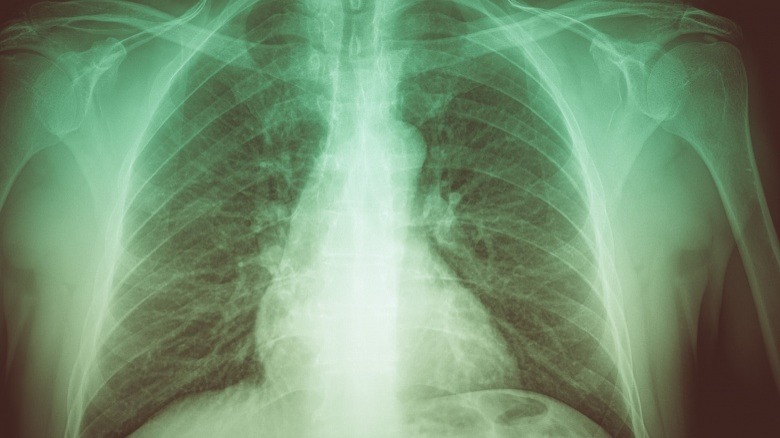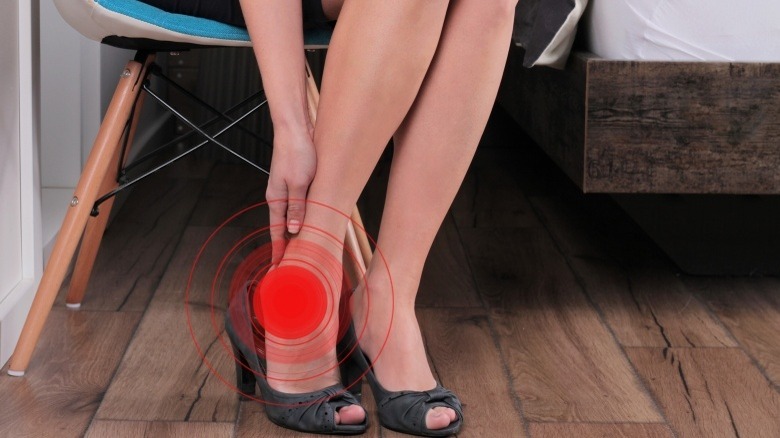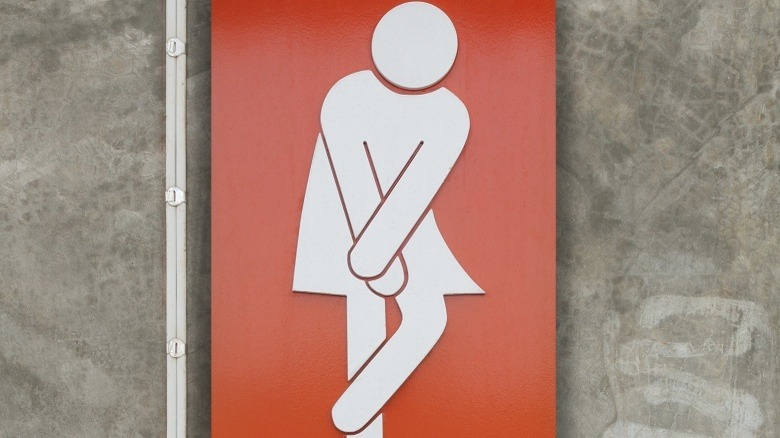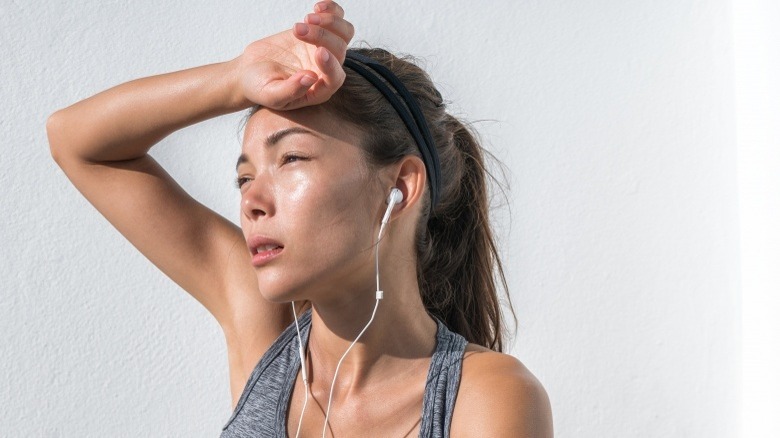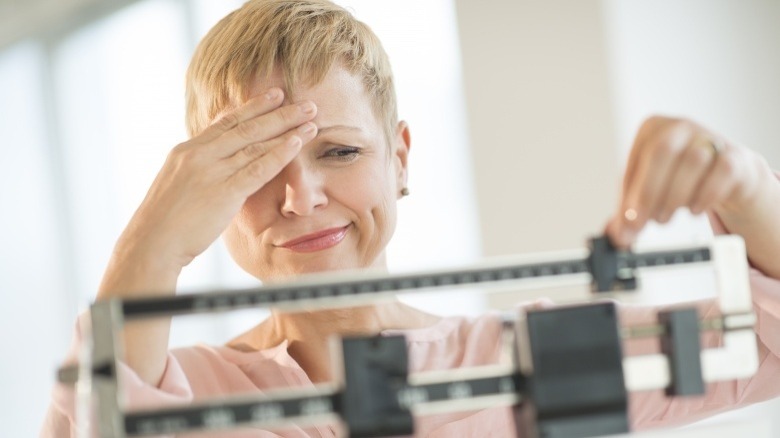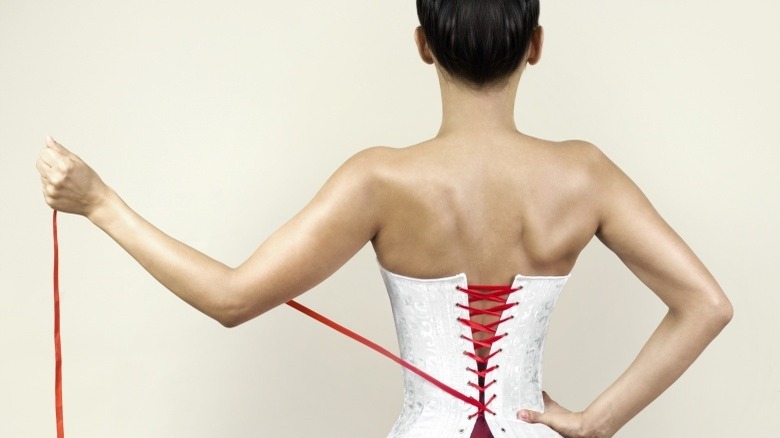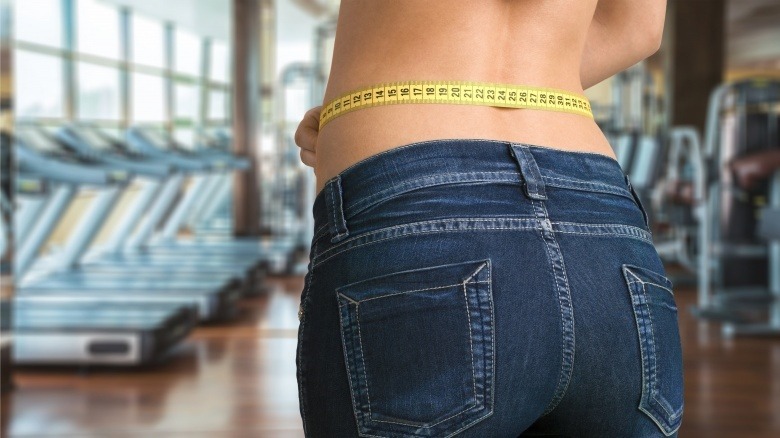Why You Should Never Try Waist Training
If you've ever skimmed through Instagram, chances are you've seen a waist trainer. Known for their trend-setting ways, Khloe, Kourtney, and Kim Kardashian (along with Kylie Jenner and even family frenemies Blac Chyna and Amber Rose) are obsessed with them for the creation of the utterly inhuman silhouette they create. It's totally normal to want to show off a toned, taut midsection, but these glorified corsets absolutely aren't worth the risks to your health or sanity. Here's why you should definitely never try waist training — not even if you're a reality star getting paid handsomely for it.
You can damage your ribs and bones
Waist training is painful, period. Aside from the indents and pressure it can place on your skin, Net Doctor warns, it can also bruise your bones, with your ribs being particularly susceptible to damage. And it'll hurt for a while. Bone bruises are more painful and last much longer than bruising anywhere else, so you might look thin, but you'll also be miserable.
It can stunt your growth
If you're under 21, it's particularly important to not rock a waist trainer, or else you're at risk for permanent damage to your body's development. Dr. Galyna Selezneva explained, "If started at a young age before the body and muscles have fully developed, waist training could have potentially permanent health risks for young people. It is absolutely not advisable to start waist training while you are still growing into an adult."
The experts at Net Doctor concur, noting that if your bones and body are still developing, waist training can lead to permanent damage to your bone structure and build.
It can screw up your digestive system
Dr. Selezneva told the York Press, "With waist training, the upper organs move upwards, and the lower organs shift downwards. This can then put a similar pressure on the abdomen — which has been known to cause constipation." It doesn't end there.
Dr. Selezneva continues, "A shift in the pressure on your internal organs means you will be less tolerant of certain foods, including gas-producing and fatty foods, and some individuals might find that normal portion sizes are too much. All of this can also increase the chances of heartburn as your stomach shifts up beyond your diaphragm, causing acid reflux."
It can cause serious medical problems
Dr. Holly Phillips explained that waist training can put extra pressure on your lungs, which could potentially kill you. "Wearing [a waist trainer] for a long amount of time makes it hard to breathe, so you're taking more shallow breaths. That can leave you with an oxygen shortage and causes a loss of consciousness, among other dangers," she told Yahoo! Beauty. "It's not good for many different things, including your energy levels."
Even scarier? Dr. Phillips noted that waist training "can lead to fluid in the lungs," causing the risk of a potentially fatal pulmonary edema and pneumonia, which can be life-threatening.
There's evidence that waist training doesn't harm just the digestive tract and lungs, but can even damage your liver, diaphragm, spleen, and kidneys from the pressure placed on them. This is especially true if you wear waist trainers or corsets for long periods of time.
It can cause problems with your legs
Chiropractor Dr. Karen Erickson warns that waist training can cause potentially life-threatening problems in your gams. The decrease in blood circulation can lead to blood clots, varicose veins, and swelling in the legs and ankles, she told the Huffington Post, as well as tingling and numbness in your lower extremities. This is especially true if you sit for long periods on time while wearing a waist trainer — and considering waist training can mess up your breathing and energy levels, chances are you'll be couch-bound for a bit if you're rocking one.
It can cause your muscles to atrophy
Proponents of waist training often claim that corsets and shapewear improve posture, but they actually make your muscles weaker, which can render your posture worse. Dr. Selezneva told the York Press, "Corset training has the potential to cause a weakening of the back and abdominal muscles, as you are not relying on using these muscles for posture when wearing the corset. The corset provides the support, not the muscles, and if the muscles are not used they will waste."
Waist training can have you scrambling to find a bathroom
Dr. Erickson and gastroenterologist Dr. John Kuemmerle explained why wearing a waist trainer can make you pee as much as a pregnant woman. And we all know that holding your pee is not a good idea.
Dr. Kuemmerle told the Huffington Post, "In someone who has weakness down below and a tendency towards incontinence, increasing intra-abdominal pressure can certainly provoke episodes of incontinence." Dr. Erickson added, "You've got all of this pressure on your bladder from the shapewear pressing down. If you postpone urinating, it can cause stress incontinence, where you leak, or it can exaggerate stress incontinence with people who already have it."
Translation: While you think people will stare in admiration at your minimized midsection, they may actually be gaping in horror that you peed your pants.
Waist training can cause dehydration
In addition to making you urinate more frequently, wearing a waist trainer can make you sweat more, especially during exercise. The problem with excessive sweating is that it can actually make you dehydrated. Dr. Galyna Selezneva warned those curious about corsets in the York Press, "Some people find that during workouts waist training can increase body temperature, causing you to sweat more... which can cause dehydration. To minimize any symptoms, we would advise people to stay fully hydrated."
We probably don't have to tell you that dehydration itself is pretty dangerous, but we will anyway just to drive the point home: mild dehydration can cause muscle cramps, tiredness or trouble sleeping, dry skin (read: aging!), dry mouth (which can lead to bad breath), constipation, and headaches.
Severe dehydration is really scary, with symptoms ranging from low blood pressure, rapid heartbeat, fever, sunken eyes (hot!), confusion, and irritability to loss of skin elasticity (hey, wrinkles!) and unconsciousness. Is the temporary appearance of an itty-bitty waist worth looking 10 years older from all this?
You can lose consciousness (which can lead to worse issues)
Back when old-fashioned corsets were in style in the 18th century, "fainting couches" were a thing. Why? One reason (aside from the toxic fumes) is because corsets and waist trainers can cause you to have shallower breathing and can lower blood circulation to and from the heart, which can make you dizzy and cause you to pass out. (This is in addition to the risk of fainting associated with the dehydration that a waist trainer can cause, too.)
Rendering yourself unconscious is terrifying enough in itself, but consider the risks associated with passing out and hitting your head to boot: concussions are no joke and can be potentially life-threatening.
It can mess up your skin
The dehydration associated with waist training is bad enough for your skin, rendering it dry, flaky, and more susceptible to wrinkles. However, that's not the only negative side effect of waist training on your skin. Sweating in a waist trainer, or simply not cleaning it enough, can cause acne, chafing, irritation, and rashes on your skin. The most common infection is folliculitis, which Dr. Maryann Mikhail explained to the Huffington Post isn't lethal by any means, but could potentially make you more susceptible to illnesses in the long run and can even compromise your immune system to a degree.
"Usually folliculitis can be easily treated with topical antibiotics," Dr. Mikhail said. "But recurrent infections may develop antibiotic resistance, meaning they get harder and harder to treat."
They can actually make you gain weight
Waist training can make you appear slimmer temporarily, but it can also make you gain weight in the long term. How? It messes with your metabolism. When you're waist training, you may lose water weight from sweat and frequent urination, which can trick you into thinking you lost actual weight — which may render you more susceptible to rewarding yourself with a donut or two later.
What's more, wearing a corset constricts your stomach, which forces you to eat less... but can lead you to eat more when you take it off later. (Think of how you unbutton your jeans after Thanksgiving dinner to make room for dessert.) Additionally, fitness expert JJ Virgin told Fox News (via the New York Daily News) you're setting yourself up for long-term damage to your weight loss goals. "[When wearing a waist trainer] you are blocking oxygen, reducing flow to your lungs, heart, and other organs which in turn slows metabolism as your cells become deprived of oxygen."
It wreaks havoc on your body image
Beyond the damage waist training can do to your body, it also has the potential to really mess with your head. Psychologist Dr. Alexis Conason warned in Teen Vogue, "When you wear this uncomfortable contraption all day, it is a constant reminder that there's something wrong with your body — that your body is not good enough as it currently is. That thought is very dangerous and destructive for young women who already have higher chances for eating disorders."
It doesn't work at all in the long run
On top of all the medical risks associated with waist training, experts say it isn't even effective in actually changing the shape of your body — so those of you looking for an easy out to escape the gym are out of luck.
"Medically, it doesn't make sense that cinching your waist tightly will make it permanently smaller," says Dr. Mary Jane Minkin, clinical professor of obstetrics and gynecology at Yale School of Medicine, told Women's Health. "Once you take the garment off, your body will return to its usual shape."
So how can you actually shrink your waist for good?
Dr. Michelle Jones-Singer explained to Fox 59, "The waist is never going to get any smaller unless we reduce the fat. The only way we're going to reduce the fat is through diet and exercise."
Personal trainer Carla White echoed Jones-Singer, telling the outlet that a lot of women who opt for waist training are simply trying to avoid the work involved with actually achieving a smaller waist. "They know that in order to do it the safe way and the healthy way," White says, "they have to completely change their lifestyle. And they have to change their eating."
You also need a better mindset, Dr. Alexis Conason told Teen Vogue. "We buy into this myth that we need to punish ourselves to inspire ourselves to change. But research shows that when we develop a compassionate relationship with our bodies, we start to be active in ways that are fun, and we begin to eat in ways that are healthy. That is where long-term changes and improvements come from."

